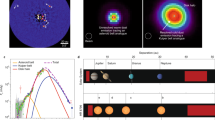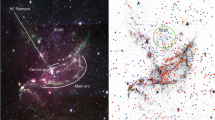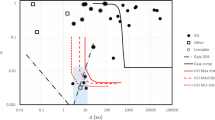Abstract
Kuiper belt objects (KBOs) are thought to be remnants of the early Solar System, and their size distribution provides an opportunity to explore the formation and evolution of the outer Solar System1,2,3,4,5. In particular, the size distribution of kilometre-sized (radius = 1–10 km) KBOs represents a signature of initial planetesimal sizes when planets form5. These kilometre-sized KBOs are extremely faint, and it is impossible to detect them directly. Instead, the monitoring of stellar occultation events is one possible way to discover these small KBOs6,7,8,9. However, until now, there has been no observational evidence for occultation events of KBOs with radii of 1–10 km. Here, we report the first detection of a single occultation event candidate by a KBO with a radius of ~1.3 km, which was simultaneously provided by two low-cost small telescopes coupled with commercial complementary metal–oxide–semiconductor cameras. From this detection, we conclude that the surface number density of KBOs with radii exceeding ~1.2 km is ~6 × 105 deg−2. This surface number density favours a theoretical size distribution model with an excess signature at a radius of 1–2 km (ref. 5). If this is a true KBO detection, this implies that planetesimals before their runaway growth phase grew into kilometre-sized objects in the primordial outer Solar System and remain as a major population in the present-day Kuiper belt.
This is a preview of subscription content, access via your institution
Access options
Access Nature and 54 other Nature Portfolio journals
Get Nature+, our best-value online-access subscription
$29.99 / 30 days
cancel any time
Subscribe to this journal
Receive 12 digital issues and online access to articles
$119.00 per year
only $9.92 per issue
Buy this article
- Purchase on Springer Link
- Instant access to full article PDF
Prices may be subject to local taxes which are calculated during checkout




Similar content being viewed by others
Data availability
The imaging data frames of the detected occultation are available from https://www.dropbox.com/s/1iesn4z2pwv110t/imgfile.zip.
References
Davis, D. R. & Farinella, P. Collisional evolution of Edgeworth–Kuiper belt objects. Icarus 125, 50–60 (1997).
Stern, S. A. & Colwell, J. E. Collisional erosion in the primordial Edgeworth–Kuiper belt and the generation of the 30–50 au Kuiper gap. Astrophys. J. 490, 879–882 (1997).
Kenyon, S. J. & Bromley, B. C. The size distribution of Kuiper belt objects. Astron. J. 128, 1916–1926 (2004).
Pan, M. & Sari, R. Shaping the Kuiper belt size distribution by shattering large but strengthless bodies. Icarus 173, 342–348 (2005).
Schlichting, H. E., Fuentes, C. I. & Trilling, D. E. Initial planetesimal sizes and the size distribution of small Kuiper belt objects. Astron. J. 146, 36–42 (2013).
Bailey, M. E. Can ‘invisible’ bodies be observed in the Solar System? Nature 259, 290–291 (1976).
Roques, F., Moncuquet, M. & Sicardy, B. Stellar occultations by small bodies—diffraction effects. Astron. J. 93, 1549–1558 (1987).
Roques, F. & Moncuquet, M. A detection method for small Kuiper belt objects: the search for stellar occultations. Icarus 147, 530–544 (2000).
Zhang, Z.-W. et al. First results from the Taiwanese–American Occultation Survey (TAOS). Astrophys. J. Lett. 685, L157–L160 (2008).
Nihei, T. C. et al. Detectability of occultations of stars by objects in the Kuiper belt and Oort cloud. Astron. J. 134, 1596–1612 (2007).
Schlichting, H. E. et al. A single sub-kilometre Kuiper belt object from a stellar occultation in archival data. Nature 462, 895–897 (2009).
Schlichting, H. E. et al. Measuring the abundance of sub-kilometer-sized Kuiper belt objects using stellar occultations. Astrophys. J. 761, 150 (2012).
Chang, H.-K., Liu, C.-Y. & Chen, K.-T. Millisecond dips in the 2007–09 RXTE/PCA light curve of Sco X-1 and one possible occultation event. Mon. Not. R. Astron. Soc. 411, 427–434 (2011).
Liu, C.-Y. et al. Search for sub-kilometre trans-Neptunian objects using CoRoT asteroseismology data. Mon. Not. R. Astron. Soc. 446, 932–940 (2015).
Zhang, Z.-W. et al. The TAOS project: results from eight years of survey data. Astron. J. 146, 14–24 (2013).
Arimatsu, K. et al. Organized Autotelescopes for Serendipitous Event Survey (OASES): design and performance. Publ. Astron. Soc. Jpn 69, 68A (2017).
Yoshida, F., Nakamura, T., Watanabe, J., Kinoshita, D. & Yamamoto, N. Size and spatial distributions of sub-km main-belt asteroids. Publ. Astron. Soc. Jpn 55, 701–715 (2003).
Elliot, J. L. et al. The Deep Ecliptic Survey: a search for Kuiper belt objects and centaurs. II. Dynamical classification, the Kuiper belt plane, and the core population. Astron. J. 129, 1117–1162 (2005).
Bernstein, G. M. et al. The size distribution of trans-Neptunian bodies. Astron. J. 128, 1364–1390 (2004).
Fuentes, C. I. & Holman, M. J. A SUBARU archival search for faint trans-Neptunian objects. Astron. J. 136, 83–97 (2008).
Fraser, W. C. et al. The Kuiper belt luminosity function from m R = 21 to 26. Icarus 195, 827–843 (2008).
Volk, K. & Malhotra, R. The scattered disk as the source of the Jupiter family comets. Astrophys. J. 687, 714–725 (2008).
Morbidelli, A. Chaotic diffusion and the origin of comets from the 2/3 resonance in the Kuiper belt. Icarus 127, 1–12 (1997).
Levison, H. F. & Duncan, M. J. From the Kuiper belt to Jupiter-family comets: the spatial distribution of ecliptic comets. Icarus 127, 13–32 (1997).
Fuentes, C. I. et al. Trans-Neptunian objects with Hubble Space Telescope ACS/WFC. Astrophys. J. 722, 1290–1302 (2010).
Fraser, W. C. The collisional divot in the Kuiper belt size distribution. Astrophys. J. 706, 119–129 (2009).
Lehner, S.-Y. et al. The Transneptunian Automated Occultation Survey (TAOS II). In Proc. Society of Photo-optical Instrumentation Engineers 84440D (SPIE, 2012).
Harding, L. K. et al. CHIMERA: a wide-field, multi-color, high-speed photometer at the prime focus of the Hale telescope. Mon. Not. R. Astron. Soc. 457, 3036–3049 (2016).
Pass, E., Metchev, S., Brown, P. & Beauchemin, S. Pipeline for the detection of serendipitous stellar occultations by Kuiper belt objects with the Colibri fast-photometry array. Publ. Astron. Soc. Pacif. 130, 983 (2017).
Lehner, M. J. et al. The TAOS project: statistical analysis of multi-telescope time series data. Publ. Astron. Soc. Pacif. 122, 959–975 (2010).
Gaia Collaboration. Gaia data release 2: summary of the contents and survey properties. Astron. Astrophys. 595, A1 (2018).
Skrutskie, M. F. et al. The Two Micron All Sky Survey (2MASS). Astron. J. 131, 1163–1183 (2006).
Castelli, F. & Kurucz, R. L. New grids of ATLAS9 model atmospheres. Preprint at https://arxiv.org/abs/astro-ph/0405087 (2004).
Acknowledgements
We thank the personnel of the Miyakojima City Museum and Miyako open-air school (Miyako Seishonen no Ie) for providing site infrastructure and access to facilities. We also thank the people of Miyako Island for supporting our observations. We thank Y. Sarugaku for constructive advice. This research has been partly supported by JSPS grants (JP26247074, 15J10278, 15J10864, 26800112, 16K17796, 18K13584 and 18K13606).
Author information
Authors and Affiliations
Contributions
K.A. is a principal investigator of the monitoring campaign described here. K.A., K.T., F.U., T.O., T.K., T.W., K.N. and J.W. developed the observation systems. K.A., K.T., F.U., Y.S. and K.I. carried out the monitoring observations. K.A. developed the data reduction pipeline and occultation detection programme, with substantial contributions from K.T. and J.W. The figures and movies, including the supplementary figures and video, were generated by the authors.
Corresponding author
Ethics declarations
Competing interests
The authors declare no competing interests.
Additional information
Publisher’s note: Springer Nature remains neutral with regard to jurisdictional claims in published maps and institutional affiliations.
Supplementary information
Supplementary Information
Supplementary Figures 1–6, Supplementary Video 1 caption.
Supplementary Video 1
Animation of the occultation event candidate obtained with the two OASES observation systems.
Rights and permissions
About this article
Cite this article
Arimatsu, K., Tsumura, K., Usui, F. et al. A kilometre-sized Kuiper belt object discovered by stellar occultation using amateur telescopes. Nat Astron 3, 301–306 (2019). https://doi.org/10.1038/s41550-018-0685-8
Received:
Accepted:
Published:
Issue Date:
DOI: https://doi.org/10.1038/s41550-018-0685-8



